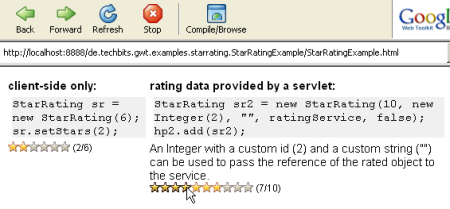I recently experimented with Google Web Toolkit (GWT) and created a widget in the process. It’s a simple rating control as seen on many websites where users can submit a rating by clicking on a number of stars.

The control currently features:
- a custom number of stars in one row (horizontal)
- a mouse hover effect
- provides an RPC service interface to store and retrieve rating data
- client side usage without a service is possible
- ui customization via CSS is possible
Some features that are missing:
- client side usage needs a listener when the rating has changed.
- the progress indicator is not customizable (image url in the java source).
- it’s not as elegant or efficient as e.g. this CSS based star rating.
- no keyboard support like the rate it widget in the gwt components library.
Nevertheless I believe this is pretty usable and maybe I’ll submit the widget to the GWT Widget Library Project if it is welcome. Anyway, feel free to use it but I won’t promise any further support – we’ll see. Here is the sourcecode of the StarRating widget.

